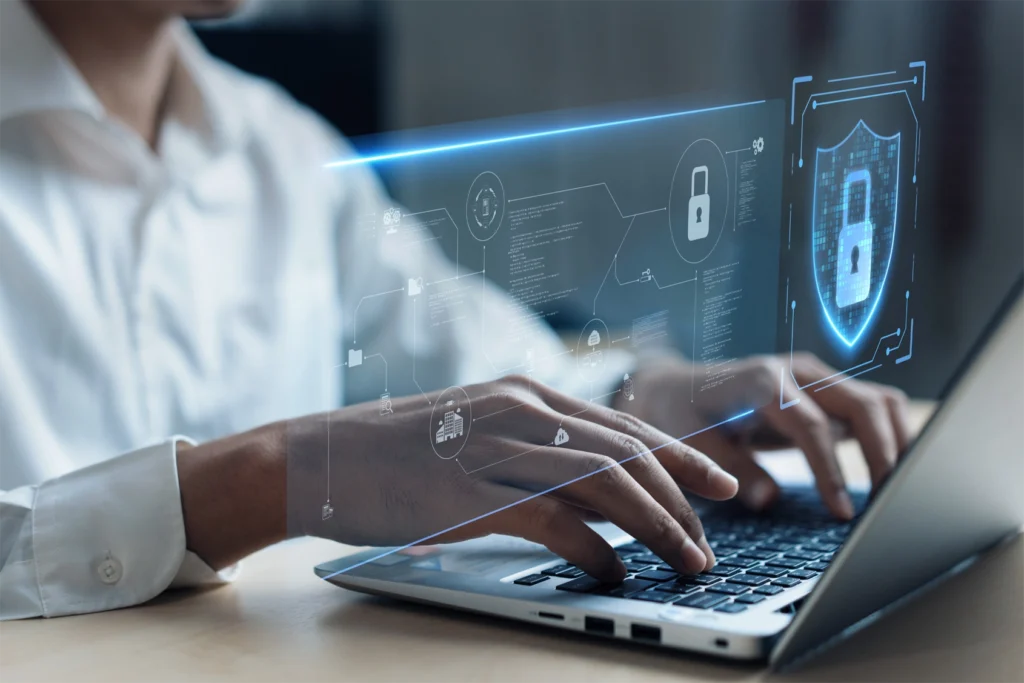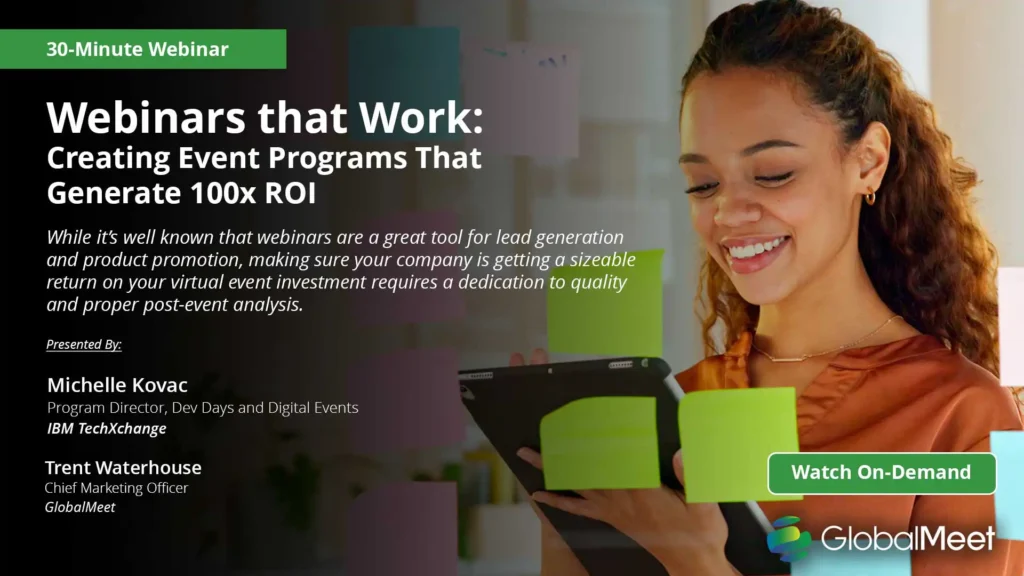
How to Ensure Secure Video Webcasting for Your Business
- by GlobalMeet Blog Team
- ,
With the rise of remote work and virtual collaboration, businesses must prioritize video webcasting security to protect sensitive information from cyber threats. As a result, video webcasting has become an essential tool for corporate communications, training, product launches, and even investor relations. As organizations increasingly rely on virtual events to connect with employees, clients, and stakeholders, the demand for secure video webcasting has never been higher. With the average cost of a data breach reaching millions of dollars, safeguarding your virtual meetings and broadcasts is not just a technical necessity — it’s a business imperative.
Why Security in Webcasting Matters
The ever-increasing popularity of video webcasting and virtual events also brings an increase in security risks and regulatory scrutiny. Cybercriminals have become more sophisticated, targeting online meetings and live streams with tactics like DDoS attacks, unauthorized access, phishing, and data interception. Sensitive information such as financial reports, intellectual property, client data, and internal policies can all be exposed if security measures are not in place, leading to critical compliance failures.
Common Threats in Video Webcasting
- Unauthorized Access: Hackers or unwanted attendees joining your webcast without permission could lead to data leaks or disruption and “zoom bombing”.
- Data Interception: Unencrypted streams can be intercepted, exposing sensitive content to malicious actors and putting organizations at risk.
- Credential Theft: Insecure login methods can lead to stolen passwords and unauthorized entry. Especially with the rise of Bring Your Own Device (BYOD) policies.
- Phishing Attacks: Participants may receive fraudulent links posing as webcast invitations, and have their systems compromised as a result.
These threats can compromise company data, damage your reputation, and even result in legal consequences, especially if compliance standards aren’t met.
Key Security Features to Look For
To ensure secure online video webcasting, it’s important to use a platform that offers enterprise-grade security controls. Here are essential features to prioritize:
End to End Encryption
Encryption ensures that data transmitted between participants and servers is unreadable to anyone who might intercept it. E2EE adds an extra layer by encrypting data on the sender’s device and only decrypting it on the receiver’s device.
Multi Factor Authentication
MFA adds a layer of security by requiring users to verify their identity using two or more authentication methods, such as a password and a phone verification code. This is especially valuable in BYOD environments where devices will have been secured via multiple methods.
Single Sign On
Single Sign On (SSO) integrations and Security Assertion Markup Language (SAML) communications can also help secure internal systems by utilizing dynamic access controls. Central authentication provides additional security where it’s needed most, reducing the risk of password breach, and improving user experience.
Access Controls and Permissions
Implementing source domain restrictions and user-level permissions ensures that only authorized individuals from specified domains or IP addresses can access your webcast.
Password Protected Events
Secure webcasting platforms allow hosts to protect meetings with passwords or PIN codes to restrict entry to invited participants only, reducing the risk of disruptive or malicious attendees.
Recording Restrictions
To protect proprietary information, the best platforms ensure that only authorized users can record or download webcast sessions.
Secure Content Distribution
Content Delivery Networks (CDNs) should support HTTPS and token-based access to prevent unauthorized sharing of webcast URLs.
Compliance Considerations for Secure Video Meetings
Organizations in healthcare, finance, legal, and other regulated industries must ensure their video webcasting tools meet compliance standards. Failure to do so can result in significant fines and reputational damage.
Key Compliance Standards
GDPR (General Data Protection Regulation): Applies to any organization handling the data of EU citizens. It gives individuals control over how their data is collected, used, and shared. It also requires data minimization, consent management, and transparency.
CCPA (California Consumer Privacy Act): Grants California residents rights to know, delete, and opt out of the sale of their personal data. It requires businesses to tell consumers what data is being collected, and why, and gives them the right to request deletion at any time.
SOC 2 (Service Organization Control 2): Focuses on how service providers securely manage data to protect the privacy and interests of their clients by assessing privacy, security, availability, and confidentiality. Companies that pass a SOC 2 Audit likely have strong systems and controls in place to keep information secure.
Using a platform that offers built-in compliance tools — such as secure data centers, encrypted storage, audit logs, and customizable access controls — is essential for meeting these requirements and ensuring that your webcasts are secure.
Best Practices for Best Practices for Secure Webcasting
Even with the right platform, businesses must adopt proper practices to ensure secure video webcasting.
Password Protection
Set up passwords for all webcasts and never share them publicly. Only distribute them through secure channels ensuring all data is encrypted in transit and at rest.
Leverage a Secure Network
Avoid public Wi-Fi for hosting or attending webcasts. Encourage staff to use VPNs and secure internet connections.
Train Employees on Security Protocols
Employees should understand the basics of cyber hygiene — such as recognizing phishing emails, using strong passwords, and not sharing login details.
Monitor Attendance and Access
Use platform features to monitor who joins your webcast. Remove unauthorized attendees immediately and disable re-entry for removed users.
Control the Audience Experience
Ensure participants can’t disrupt the webcast with loud noises or disruptive chats, restrict screen and content sharing to hosts. Lock the meeting once it has started to prevent new participants from joining.
Keep Software and Platforms Updated
Use the latest version of your webcasting platform to ensure you have the most up-to-date security patches and features.
Why Chose GlobalMeet for your Secure Video Webcasting
For businesses that need a trusted, secure solution for webcasting, GlobalMeet stands out with its robust, enterprise-grade security features. GlobalMeet is also unique with dedicated in-house information security personnel and Data Privacy Officer.
- Private Cloud: GlobalMeet owns and operates our own private streaming-as-a-service infrastructure to reduce cyberattack targeting risks.
- End-to-End Encryption: Ensures that content and attendee data is encrypted at every stage of delivery.
- Multi-Factor Authentication: Available for all users, reducing the risk of unauthorized access and unauthorized attendees or presenters.
- Custom Access Controls: Restrict access by IP, email domain, or invitation-only settings while limiting or preventing multiple logins using the same email address.
- Compliance Certifications: Supports GDPR, CCPA, and SOC 2 requirements.
- Secure Data Centers: Hosted in geographically diverse, ISO 27001-certified facilities.
- Controlled Content Distribution: Tokenized URLs and viewer-specific access help prevent content leaks.
- Audit Logs and Reporting: Get detailed insights into who accessed what, and when.
Additionally, GlobalMeet offers seamless integrations with enterprise communication systems, single sign-on (SSO), and dedicated customer success teams to help you manage secure events from planning to execution.
Conclusion
As remote collaboration and digital communication continue to grow, ensuring secure video webcasting is critical to protecting your business and maintaining trust with stakeholders. The risks of unprotected content — from data breaches to compliance violations — are too significant to ignore.
By choosing a platform like GlobalMeet and following best practices such as encryption, access control, and employee training, businesses can confidently host secure, compliant webcasts that protect their most valuable asset: information.
Secure your next webcast with confidence — because in today’s digital world, security is not optional, it’s essential.


